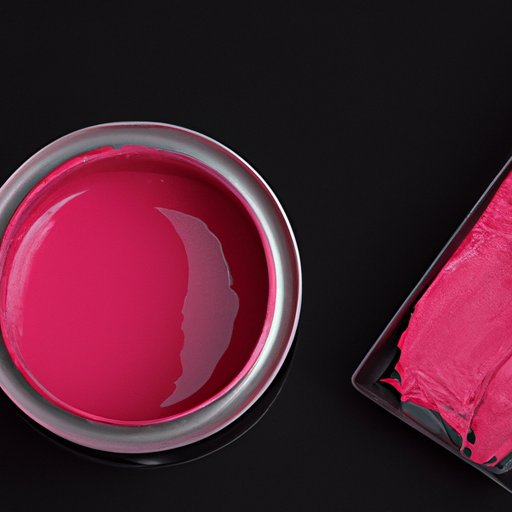
I. Introduction
Hot pink is a bold and vibrant color that can add life to any project. However, making hot pink paint can be a challenge as it requires a specific combination of pigments. In this article, we’ll explore how to make hot pink paint step-by-step, including materials needed, pigment options, safety guidelines, and more.
II. Step-by-Step Guide
There are several pigments that can be used to make hot pink paint, including magenta, quinacridone rose, and fluorescent pink. Here is a step-by-step guide to creating hot pink paint using each pigment type:
- Magenta: Start with a white paint base and add magenta pigment slowly, stirring it continuously until you reach the desired shade. Be careful not to add too much magenta, as it can make the paint darker than you want.
- Quinacridone Rose: Begin with a white paint base and add quinacridone rose pigment in small amounts, mixing continuously until the desired shade of pink is reached. This pigment has a transparent quality, allowing you to build on the color without it becoming too overwhelming.
- Fluorescent Pink: Start with a white paint base and add a small amount of fluorescent pink pigment, stirring continuously until the desired shade is reached. This pigment is highly concentrated, so it is important to add it incrementally to avoid overpowering the paint.
Remember to always start with a white base to ensure the brightest, most vibrant results. To achieve a lighter, more pastel shade, simply add more white paint to your mixture.
III. Materials Guide
Here is a list of materials you will need to make hot pink paint:
- White paint base
- Pigments (magenta, quinacridone rose, and/or fluorescent pink)
- Paint palette
- Paintbrushes
- Measuring spoons
- Mixing container
It’s important to use high-quality materials when making paint, as it can affect the final outcome of your project. If you’re having trouble finding a specific material, try looking online for alternatives or consulting with an art supply store.
IV. Pigment Guide
Choosing the right pigment is crucial to creating the perfect shade of hot pink. Here are some common pigments used for making hot pink paint:
- Magenta: A bold and intense pigment that leans towards the purple end of the pink scale.
- Quinacridone Rose: A versatile and transparent pigment that can create shades ranging from light pink to deep magenta.
- Fluorescent Pink: A highly concentrated pigment that gives off a bright and fluorescent tone, perfect for projects that require a vivid pop of color.
When choosing a pigment, consider the type of project you are working on and the overall effect you want to achieve. Experimenting with different pigment combinations can also lead to interesting and unique shades.
V. Practical Tips
Here are some practical tips to help you make hot pink paint:
- Measure pigments carefully to avoid adding too much or too little.
- Blend pigments thoroughly to create an even shade.
- Add pigments in small amounts until the desired shade is reached.
- Use a stirrer or palette knife to mix the paint instead of a brush, as it can cause clumping.
- For a smoother, more vibrant finish, apply two to three layers of paint to your project, allowing each layer to dry in between.
VI. Safety Guide
Making paint can be a fun and rewarding experience, but it’s important to prioritize safety. Here are some tips to keep in mind:
- Wear gloves, aprons, and masks when handling pigments and other materials.
- Opt for a well-ventilated room or studio to avoid inhaling fumes or other harmful particles.
- Store pigments and other materials in safe, dry places away from children and pets.
- Dispose of excess paint and pigments properly.
VII. Different Shades
By adjusting the amounts of pigment used, you can create a variety of shades of hot pink. Here are some examples:
- A lighter shade of hot pink can be achieved by adding more white paint to the mixture.
- For a more muted, pastel look, mix hot pink with a small amount of gray paint.
- By mixing hot pink with red or orange pigments, you can create a warmer and more vibrant shade of pink.
Don’t be afraid to experiment with different pigment combinations and ratios to create unique shades that suit your project’s needs.
VIII. Conclusion
Creating hot pink paint requires a bit of experimentation and knowledge of pigments, but the results are worth it. By following these step-by-step instructions and safety guidelines, you can create a bold and beautiful shade of hot pink that will add life to your projects.





